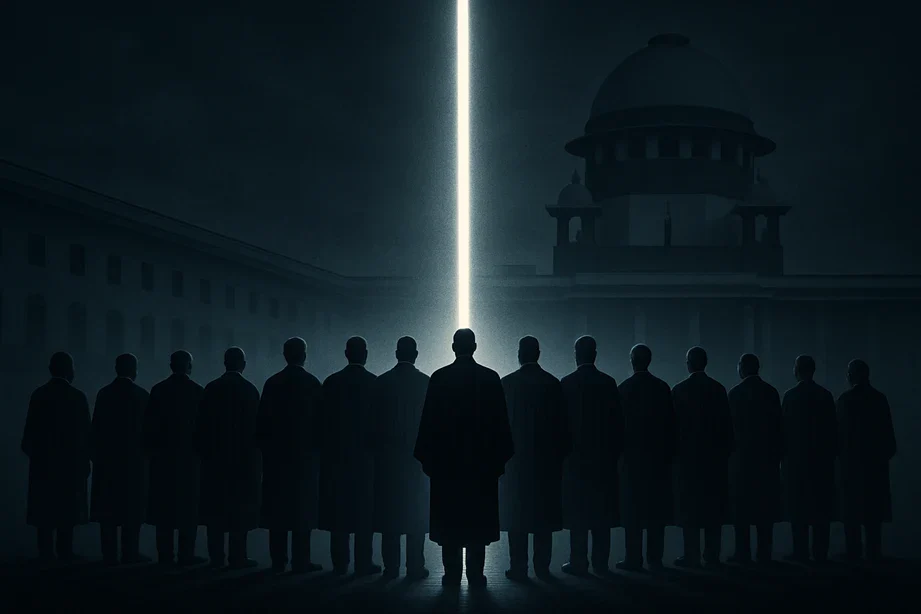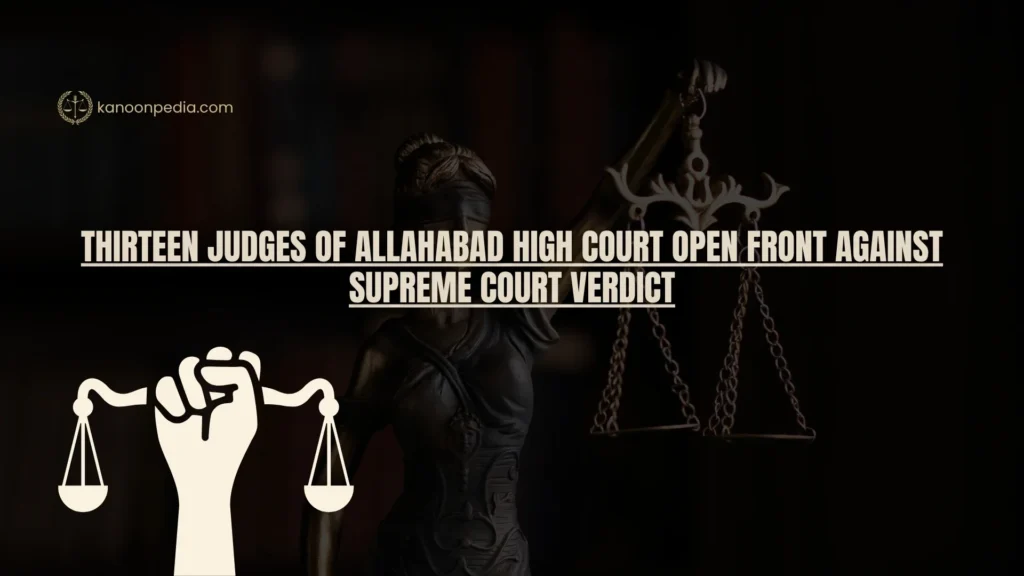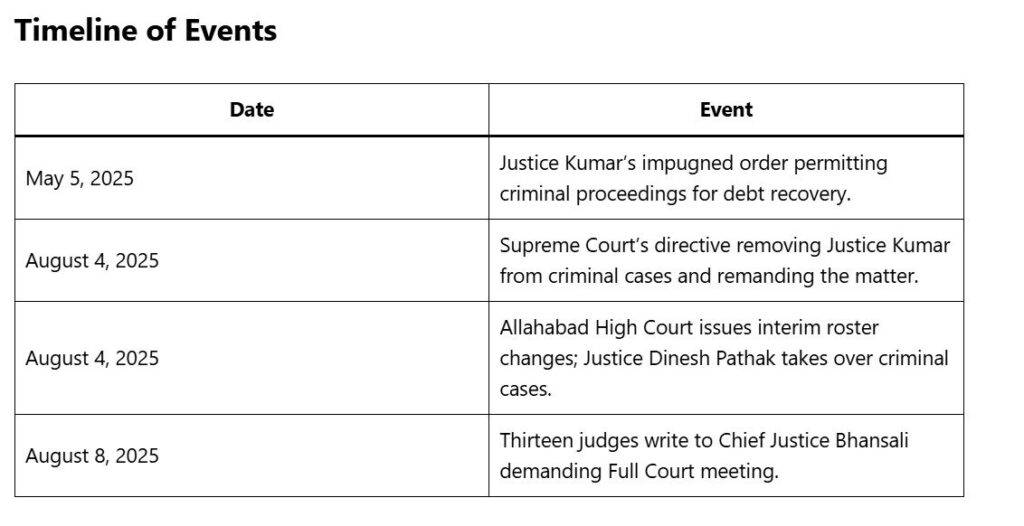The recent turmoil in the judiciary has captured national attention as Thirteen Judges of Allahabad High Court Open Front Against Supreme Court Verdict, challenging administrative norms and raising fundamental questions about the separation of powers. In this blog, we analyze why Thirteen Judges of Allahabad High Court Open Front Against Supreme Court Verdict, how this unprecedented move unfolds, and what it means for India’s legal landscape.

Table of Contents
Thirteen Judges of Allahabad High Court Open Front Against Supreme Court Verdict: Context and Background
On August 4, 2025, a Bench of the Supreme Court headed by Justices J.B. Pardiwala and R. Mahadevan issued a directive urging the Chief Justice of the Allahabad High Court to relieve Justice Prashant Kumar from criminal case rosters until retirement. This stern rebuke came after Justice Kumar’s May 5 order permitted criminal prosecution as an alternative to civil recovery in commercial disputes. The directive stated that Justice Kumar should only sit on a Division Bench alongside a more experienced High Court judge—a clear admonishment of his legal reasoning.
In response, Thirteen Judges of Allahabad High Court Open Front Against Supreme Court Verdict by writing to Chief Justice Arun Bhansali. Led by Justice Arindam Sinha, these judges demanded a Full Court meeting to deliberate on the Supreme Court’s administrative overreach. They contended that the apex court lacks supervisory authority over High Courts and expressed “surprise and distress” at the tone and tenor of the August 4 order.

Why Thirteen Judges of Allahabad High Court Open Front Against Supreme Court Verdict Matters
This confrontation underscores three core issues:
- Judicial Independence
When Thirteen Judges of Allahabad High Court Open Front Against Supreme Court Verdict, it highlights fears that administrative directives from the Supreme Court may encroach on High Court autonomy. The judges argue that each High Court governs its roster and assignments without oversight from a higher bench, ensuring balanced distribution of cases and judicial integrity. - Administrative Jurisdiction
The legal fraternity is divided over whether the Supreme Court possesses administrative jurisdiction to reassign a High Court judge’s duties. By pressing back, Thirteen Judges of Allahabad High Court Open Front Against Supreme Court Verdict emphasize that supervisory power is limited to curative and appellate jurisdiction, not day-to-day roster management. - Tone and Respect in Judicial Communications
The letter from Thirteen Judges of Allahabad High Court Open Front Against Supreme Court Verdict specifically objected to “harsh conclusions” in the Supreme Court’s order. Judicial collegiality relies on mutual respect, and this dispute reveals tensions about how judgments and directives are communicated among different tiers of the judiciary.
Timeline of Events
- May 5: Justice Prashant Kumar’s order allows criminal prosecution for money recovery in civil disputes.
- August 4: Supreme Court’s Bench issues a directive to reassign Justice Kumar away from criminal cases until retirement.
- August 4: Allahabad High Court temporarily adjusts its roster: Justice Kumar to hear land acquisition, writs, and environment cases with Justice M.C. Tripathi; Justice Dinesh Pathak takes over criminal cases.
- August 8: Thirteen judges send a letter requesting a Full Court meeting to discuss the Supreme Court verdict.

Legal and Constitutional Implications
Separation of Powers within the Judiciary
The Thirteen Judges of Allahabad High Court Open Front Against Supreme Court Verdict bring to light the delicate balance of power within India’s judiciary:
- Appellate Power vs. Administrative Control: While the Supreme Court has the power to hear appeals and set aside High Court orders, it traditionally lacks administrative control over High Court judges. The petition by Thirteen Judges of Allahabad High Court Open Front Against Supreme Court Verdict reasserts this principle.
- Judicial Accountability: Justice Prashant Kumar’s legal reasoning sparked debate over judicial accountability. The apex court found his preference for criminal remedies over civil ones “unacceptable,” but the response from Thirteen Judges of Allahabad High Court Open Front Against Supreme Court Verdict suggests a need for clear guidelines rather than punitive roster changes.
Precedents and Comparative Practice
In other federations, apex courts rarely intervene in High Court rosters. The Thirteen Judges of Allahabad High Court Open Front Against Supreme Court Verdict point to comparative jurisprudence where administrative matters remain within the provincial or state judiciary.
What Comes Next?
The much-anticipated Full Court meeting will determine whether the High Court collectively rejects the Supreme Court’s directive. Potential outcomes include:
- Formal Resolution: A resolution by Thirteen Judges of Allahabad High Court Open Front Against Supreme Court Verdict refusing to comply, citing constitutional boundaries.
- Dialogue with the Supreme Court: Joint discussions to clarify administrative jurisdiction and set protocols for future disputes.
- Judicial Review: A petition in the Supreme Court challenging its own order, testing the limits of writ jurisdiction.
Responses from Legal Experts
Legal scholars are divided. Proponents of the Supreme Court’s action argue that maintaining jurisprudential consistency across jurisdictions justifies extraordinary supervisory steps. Critics counter that administrative measures should follow collegium recommendations and adhere to procedural safeguards, lest they compromise judicial independence.
Professor Anjali Menon (National Law University) observes:
“While the Supreme Court must ensure uniformity in legal interpretation, any administrative intervention must respect the separation of functions enshrined in the Constitution.”
Senior Advocate Rohit Khanna comments:
“The tone of the directive was regrettable. Critiquing a judge’s legal reasoning is one thing; stripping roster assignments without notice crosses a line.”
FAQ
Q1: Why did the Supreme Court direct removal of Justice Prashant Kumar from criminal cases?
A1: The Supreme Court criticized Justice Kumar’s reasoning that criminal prosecution could substitute for civil remedies in money recovery disputes, deeming it legally unsound.
Q2: Do Supreme Court directives typically affect High Court rosters?
A2: No. Administrative control over High Court judges is usually vested in the respective High Courts, making this directive exceptional.
Q3: What authority do the Thirteen Judges of Allahabad High Court Open Front Against Supreme Court Verdict claim?
A3: They assert that the Supreme Court lacks administrative supervisory authority over High Court rosters and assignments.
Q4: When will the Full Court meeting take place?
A4: The date is yet to be announced by Chief Justice Arun Bhansali, following the judges’ request.
Q5: Could this dispute affect pending cases?
A5: Interim roster changes have already reassigned cases; long-term impact depends on the Full Court’s resolution.
Q6. What is a Full Court meeting?
A. A Full Court meeting involves all sitting High Court judges convening under the Chief Justice to decide institutional matters such as administrative directives and policy resolutions.
Conclusion
The confrontation where Thirteen Judges of Allahabad High Court Open Front Against Supreme Court Verdict underscores a deeper constitutional tension between judicial accountability and judicial independence. While the Supreme Court has a duty to correct perceived judicial errors, administrative interventions must respect procedural fairness and the federated structure of India’s judiciary. The Full Court meeting, once convened, will not only determine the immediate fate of Justice Prashant Kumar’s criminal docket assignments but may also recalibrate institutional boundaries between India’s High Courts and its apex court.
You may also read : A Temporal Analysis of the Supreme Court of India’s Workload: Empirical Insights and the Path Forward